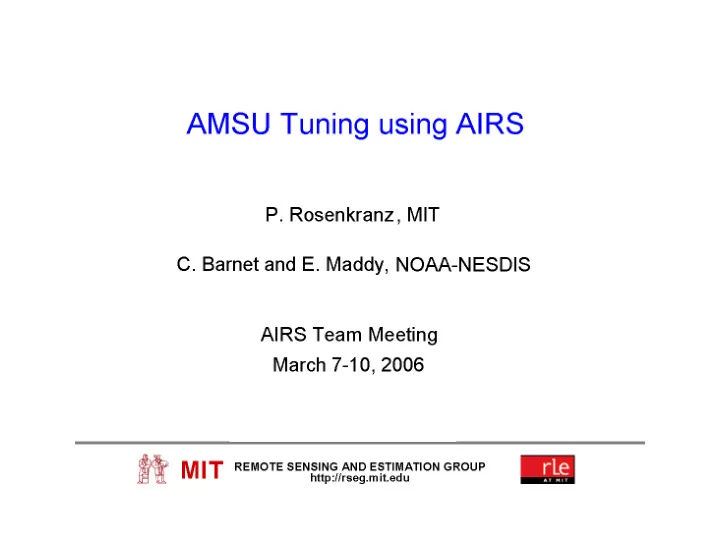

Objective: Compatibility of microwave and infrared radiances for use in the retrieval algorithm. Procedure: For 29 months of data (Aug. 2003 - Dec. 2005), 1) Using both IR & MW data, do cloud clearing and retrieval. If the retrieval passes the Level-2 clear tests and the cloud-cleared radiances pass clear and aerosol tests, then 2) Re-run the retrievals without cloud-clearing for the clear cases using only IR data (averaged over 9 FOV's). Reject any retrieval with high residuals. 3) Compute AMSU T B 's from the AIRS clear-case retrievals using the MW-RTA. 4) Compare observed AMSU T A 's to computed T B 's and calculate tuning coefficients for each channel and scan position. Initially, only ocean-surface cases have been examined. Global comparisons are planned for the future. Formulation of AMSU tuning in Version 4.1+: <obs.T A - calc.T B > = Bias(chan,pos) + Slope(chan,pos) * obs.TA also error_estimate(chan,pos) for <obs.T A - calc.T B >. Options: Bias only, Slope only, both. Calibration can produce a Bias or Slope. Antenna sidelobes are expected to produce a negative Slope term (which could be represented simply as a Bias over a limited range of T B) . Transmittance error can produce a Bias and Slope.
Expected magnitude of sidelobe effects (for NOAA orbit, and with oppositely-defined sign) from T. Mo, IEEE Trans. Geosci. Rem. Sens . v. 34, pp. 405-412 (1996)
Temperature channels AMSU-6 shows some cloud contamination in the AIRS retrieval at both ends of the scan.
After exclusion of profiles with deviations from mean > 1 K for chan 6: (All channels are subsequently excluded for those profiles.)
Bias-only (red) compared to V.4 bias (black, which was tuned to ECMWF): All are more negative than V.4, but chan. 13 still has a more positive bias than the others.
Example of a negative slope (chan. 5, pos. 15): Chans. 4 & 6 are similar.
Chan. 8, pos. 1 has a small positive slope: Chan. 9 & 10 also have small slopes.
Chan.8, at pos. 15 the slope is larger: A 5% opacity increase would remove this slope, but introduce a negative slope at pos. 1.
For some channels (eg. ch. 12, pos. 15), a slope is not well defined. Chan. 11, 13 & 14 are similar.
AMSU residuals calculated in the Final retrieval stage
Window channels Surface emissivity is strongly dependent on wind speed. The dependence on wind direction relative to the direction of propagation is ~10% of the magnitude. Brightness temperature varies linearly with emissivity: T B = T Bfresnel + τ ∆ε (T S - T Bsky ) where τ = atmospheric transmittance for the upward path; T S is the surface skin temperature; ε is the surface emissivity and ∆ε is the emissivity increment caused by wind; T Bsky is the downward-propagating sky brightness temperature (including the cosmic background contribution) calculated using the secant ratio approximation; T Bfresnel is the value of T B calculated using ε for a smooth surface (but T Bsky is still calculated for the effective reflected path given by the secant ratio). Assume that T B = T A - Bias; then T A - T Bfresnel = Bias + ( ∆ε /w) [ w τ (T S - T Bsky ) ] where w is the wind speed. If ∆ε /w is constant for a given angle and frequency, then it can be determined as the slope in a linear regression of (T A -T Bfresnel ) vs. the quantity inside the square brackets. Directional dependence of ∆ε /w can be added as separate predictors in the regression.
Initial regression of obs.-calc. against wind speed:
Obs.-calc. after wind correction, plotted vs. water vapor:
Residuals for AMSU-1, pos. 15, after regression against 3 wind predictors [wind, wind * cos( φ ), wind * cos(2 φ )] and vapor, plotted versus surface temperature:
Bias from the regression. Possible cloud contamination at high angles?
Coefficients of wind variables and water vapor in the regression:
Conclusions 1) ~1% of the "clear" cases are contaminated with high clouds that are detected in AMSU ch. 5 and 6. 2) There are some transmittance differences (amounting to < 1K in T B ) between MW and the IR-retrieved profiles near the tropical tropopause (ch. 8, ~200 mb) and in the stratosphere (ch.13, ~5 mb). 3) After elimination of wind, wind direction, and water-vapor transmittance effects, AMSU window channels have biases that cannot entirely be accounted for by antenna sidelobes, and therefore cannot be extrapolated to land surfaces. 4) The preliminary tuning delivered to JPL uses only bias terms and revises only the temperature channels, not the V.4 window-channel coefficients. 5) Further work on AMSU tuning should use a global dataset to include polar temperature profiles for opaque channels and forested (high emissivity) surfaces for window channels.
Recommend
More recommend